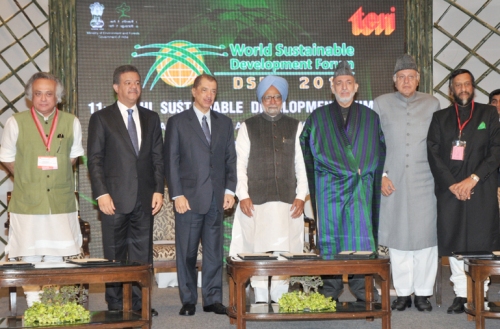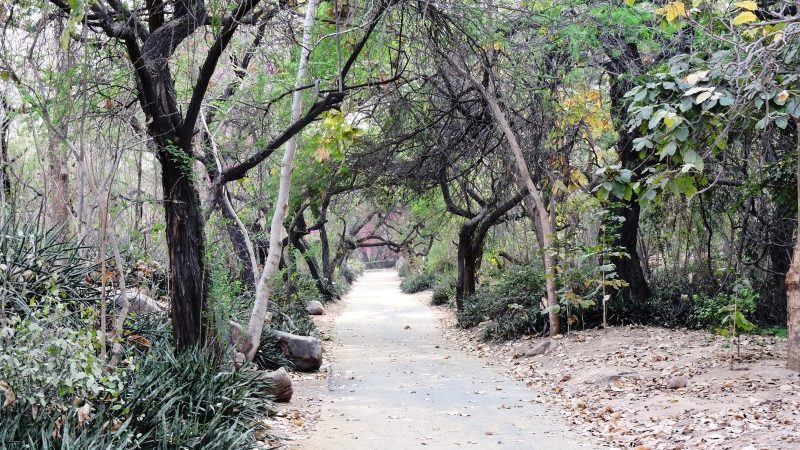Prime Minister Inaugurates the Delhi Sustainable Development Summit 2011

The flagship conference, the 11th Delhi Sustainable Development Summit (DSDS) organised by The Energy & Resource Institute (TERI) was inaugurated today at Taj Palace in New Delhi. The DSDS this year is themed on “Tapping Local Initiatives and Tackling Global Inertia”. The summit envisaged the presence of various stakeholders, multilateral and bilateral development organizations, non-government sector, corporate houses and various research and academic institutions. DSDS 2011 was inaugurated by the Hon’ble Prime Minister of India Dr. Manmohan Singh in gracious presence of H.E. Dr. Leonel Fernandez, President of Dominican Republic; H.E. Mr. James Alix Michel, President Seychelles; H.E. Mr. Hamid Karzai, President Afghanistan; Mr. Jairam Ramesh, Hon’ble Minister for Environment and Forests, Dr. Farooq Abdullah, Hon’ble Minister for New & Renewable Energy among others.
During the inauguration, Dr. Manmohan Singh was awarded TERI’s Sustainable Development Leadership award for his excellent leadership and significant contribution in creating impetus to confront climate change issue in the present scenario. Addressing the gathering, Dr. Singh said, “The theme Tapping Local Initiatives and Tackling Global Inertia reflects the fact that we have to act at two levels: the local and the global – in dealing with the issue of sustainable development.” Sharing his vision of achieving this, the PM stated that, “We require collective action at both levels so that local good and global good can be aligned and can reinforce each other. We are also taking action on our own in the form of a National Action Plan on Climate Change (NAPCC).”
In this speech, the Prime Minister informed that the broad objective that has been set is to reduce the emissions intensity of GDP by 20% between 2005 and 2020. The seven missions in this regard, viz. energy efficiency, solar energy, sustainable habitat, water, sustaining the Himalayan Ecosystem, agriculture and strategic knowledge for climate change were also shared by the PM. “We will shortly launch the last of the 8 National Missions under the Plan, which is called Green India, which will result in the regeneration of 6 million hectares of degraded forest land.” The PM also informed that the Twelfth Five Year Plan, which will cover the period of 2012-2107, will focus on specific initiatives which are needed to be put our development on a path consistent with low carbon growth.
Dr. Manmohan Singh used the DSDS platform to emphasized that even as the world waits for meaningful agreements on global mitigation action, we in India have committed ourselves to keeping our per capita consumption below the average for an industrial country. This is an important commitment since it ensures that if industrial countries do more themselves to reduce their green house gas emissions, which they should, they automatically ensure that emissions are contained. In fact, the faster the industrial countries reduce their per capita emissions, the quicker will the self imposed constraint require action in India. With this, Dr. Singh noted that concern for ecological sustainability is not a new phenomenon and shared the long cultural tradition of frugality and simple living in harmony with nature inherent to India.
The Prime Minister also reminded the audience that all religions in India imbibe the care for nature. As goes an ancient hymn from the Upanishads: Peace on Earth, peace in space…peace for the trees, peace towards cattle, peace towards goat. He concluded with his belief that charting the new path of sustainable development is not beyond our collective imagination. “Life as we know it on our beautiful planet is at stake”, was the direct message from the PM which ensured the audience the head of the world’s largest democracy and the second largest country is keen on action for sustainability.
Dr. R.K. Pauchari, Director General, TERI also put forward his thoughts during the inaugural function. “Irrespective of which country reduces emissions by what levels, it is well accepted now that reducing emissions of GHGs is associated with a range of significant co-benefits at the local level, including an increase in energy security and reduction in pollution, which would provide major health benefits.” he stated in order to highlight that local initiatives need to essentially target the realization of these co benefits.
Dr. Pachauri also emphasized that action in the right direction will occur only if a range of barriers and impediments are removed through institutional innovations and policy initiatives. The panel on energy aspects, renewable energy, pricing and opportunities and barriers in dealing with Renewable energy mechanism and its implication were also discussed by the renowned dignitaries during the inaugural.
The DSDS 2011 summit will be a three days affair highlighting the key issues in ensuring a sustainable world.




If a Country of 22 Million and three times the size of India feels it a requirement.About Time the Climate Gurus(read Climate Ganstars) wake up in iNdia and astrat the process of transition into the global green greed free economy.Meaning 100% Employment.100% Zero Emission by 2030 and 100% Global leaders in manpower and green technolgy.
Pricing Carbon
Labor HQ posted Thursday, 24 February 2011
We know that acting on climate change isn’t just the right thing to do, it is also an essential economic reform.
Australians are the biggest polluters per capita in the developed world, even more than the United States of America. Our climate is changing and we need to reduce carbon pollution now.
Acting Now
As Prime Minister Julia Gillard said today, history teaches us that in times of historic change, like the industrial and technological revolutions, the countries and economies that prosper are the ones that lead and shape that change.
Tony Abbott would have us wait and risk being left behind. Imagine if Bill Gates had said, “I’m not sure about this computer thing I’ll wait and see for 10 years?” – where would Bill Gates be now?
If Australia was to be left behind right now it would risk the jobs of the future and threaten our long term prosperity.
Now is the right time to act.
A carbon price and how it will happen
Our two-stage plan for a carbon price mechanism will start with a fixed price period for three to five years before transitioning to an emissions trading scheme.
The Government will propose that the carbon price commences on 1 July 2012, subject to the ability to negotiate an agreement with a majority in both houses of Parliament and pass legislation this year.
A carbon price is a price on pollution. It is the cheapest and fairest way to cut pollution and build a clean energy economy. It is the right and necessary thing to do.
The best way to stop businesses polluting and get them to invest in clean energy is to charge them when they pollute.
The Government will then use every cent raised to:
• Assist families with household bills;
• Help businesses make the transition to a clean energy economy; and
• Tackle climate change and invest in a clean energy future.
A carbon price will mean that the businesses with the highest levels of pollution will have a very strong incentive to reduce their pollution.
Next steps
The Multi-Party Climate Change Committee along with the Non-Government Organisation and Business Roundtables on Climate Change will continue to discuss important elements of the proposal in the coming months.
Australia is a confident nation and we are good at change. When we floated the dollar and when we reduced tarriffs, we prooved just how good at change we were – when we make change we find the opportunities to build a prosperous future.
Now is our time to build a clean energy future.
http://www.alp.org.au/blogs/alp-blog/february-2011/pricing-carbon/
http://www.youtube.com/watch?v=bNhU7oBH3MI&feature=player_embedded
Effective CO2 policy ought to include the following:
•Clean Air Act reform
So long as old dirty plants retain an economic advantage against new clean ones, efforts to bring low-CO2 generation face unnecessary regulatory headwinds.
•Output-based emissions standards
Current emissions rules discourage investments in efficiency, inadvertently mandating greater CO2 release. This can be fixed in the law or in the courts, but we cannot sustain a conflict between two elements of our environmental policy.
•Explicit incentives to balance penalties
The carbon price required to shut down dirty generation is not sufficient to bring clean generation on line. A system that provides direct economic links between CO2 sources and sinks without regulatory intermediation will be critical. A stick is not a negative carrot.
•Capital cost incentives
CO2 pricing can only affect the variable cost of operation. Given the capital-intensivity , regulation may need to include some type of additional inducement to deploy capital.Ideally the Green Bank with Green Bonds.
•Technology neutrality
The goal of CO2 regulation is to reduce emissions of CO2, not to deploy technology X or bankrupt company Y. Any policy that confuses paths and goals introduces new Pareto inefficiencies into a market that already has plenty.
Sauman from Salt Lake City , West Bengal Friday, 4 February 2011, 17:04
It seems that all can be solved by setting a carbon price which will be higher than that an efficient market would require (and devoting any extra revenue to resolve the equity/poverty issues)Theoretically yes, but calculating what that number ought to be is effectively impossible outside of a market mechanism.The cleanest way to do this is with cap & share &trade.
Sauman from Salt Lake City , West Bengal Friday, 4 February 2011, 17:04
Hon PM:
Managing a resource based extraction Boom backed up by a Carbon price instead of a Cap and Trade .In other words pouring oil to fire.The bill that was $6 Billion last week for restructuring will probably be $12 Billion by the time Cyclone Yasi does her job.If science and technology(something that has been pointed out as the key improvement areas) are to be taken as face value,Australia is posed for greater on going threats(courtesy the extraction boom-some call it climate change issue).Meaning the targeted,transparent,temporary mandates could soon change to opaque,permanent,scattered .I hear about the non romantic chivalarious futuristic approach to governance.But cant see the logic deliberated in terms of demand and supply base.If the examples of extraction economies of the present world governance is to be taken into account.One needs to just see beyond the shores of the great southern land about the complete failure of them.Quick fixing by printing money(something that our ally US had done systematically for the most of last 7 decades ) is an indicator of how slowly but surely is headed fo a crash.Wander why China and Russia are walking away from the green dollar .But then we are the greatest trading partners of China and the US is an ally.Mining isnt a boom.Mining can only be a boom when it supports an own home grown Industry base.But then ,thats too much of a hassle to enagage in,when one can just dig and ship it overseas.I guess value addition economics and value added services (part of the Knowledge Nation vision) is just a mere paper excercise.Something the pundits in Canberra love as armchair policy makers.Using mass emotion at times of calamity and subsequently using a quick band aid fix has been the demise of many .Unless an Holistic sustainable ,secure ,safe demand based economy backed with Public,Private,People and Producer structuring is put in place, the short term gains will cascade into long term debacles.Thats the burden that the future can handle.She will be alrite.After all it is the Land of Milk and Honey.There is still ample time to fix this.But then I am telling you to do your job.
Hi Sanjeev:It can indeed be short.Keep it clean,green and rich.:)
whut a short post by Sauman Das Gupta … by the time one reads it.
Clean Carbon India Card TM can piggy back with the UID scheme acting as poverty and quality of lkife indicator across the whole population.
Would be gfood if the Cap and Share is rolled into mainstream Economy.
1 The Cap C&S can be implemented nationally, at
EU level, or around the world. If it was adopted
internationally, a world Atmosphere Protection Trust
would cap (limit) global greenhouse gas emissions at
…their present level. Then, using the best scientific advice,
it would tighten the cap each year so that emissions
eventually fell to a level at which they were no longer
causing the climate to change. The Atmosphere
Protection Trust would share out Production
Authorisation Permit (PAP) quotas between countries
on an adult per capita basis.
2 The Share Every year, national Climate Protection
Trusts would share out whatever emissions tonnage had
been allocated to them by the Atmosphere Protection
Trust by issuing PAPs equally to every adult resident
in their country. Independent Trusts are important
to provide a third sector in the economy – alongside
companies and governments – with the remit of both
protecting our “climate commons” and sharing out the
benefits to all.
3 The Sale When people received their PAPs, they
could take them to a bank, post office or other financial
institution and sell them at the current market rate,
exactly as if they were foreign currency notes. On the
other hand, they might choose not to authorise the
production of fossil fuel the permits conveyed. In this
case, they would destroy their permits and thus reduce
the world’s emissions by their share.
This annual distribution of fossil fuel PAPs would
provide those who sold them with a supplementary
income to offset the rising cost of fossil fuels. The
tighter the cap became, the fiercer the competition for
PAPs would become and the more we would get when
we sold them. Indeed, since a majority of the world’s
population use little energy and would thus get more for
their PAPs than their cost of living went up, there would
be pressure on the global Atmosphere Protection Trust
to accelerate the rate at which it was tightening the cap.
4 The Buy Surprisingly few companies introduce coal,
oil and gas into the world economy. These firms would
need to acquire enough PAPs to cover the eventual
emissions from the fuels they sold. Only these fossil
energy suppliers would need to buy permits from the
banks or other financial intermediaries. Fuel users,
whether families, companies or utilities, would never
need them to purchase fuel, keeping the system simple
and easy to manage.
5 The Enforcement A corps of inspectors would be set up
to verify that the quantity of fossil fuel each company
produced was in line with the number of PAPs it had
bought. Unless there was serious undiscovered cheating,
the world would be certain to stay below its emissions
target. An important feature of C&S it that policing it
would only involve fossil fuel producing companies.
Other companies and individuals would not be affected,
again keeping the system simple.
C&S would drive a multi-pronged approach
The way we live Money and support to change to
lower carbon living.
New technologies Low carbon products and services
will be more competitive.
Community initiatives Community Transition Funds
with participatory budgets for local conservation,
renewable energy and carbon sinks.
Better regulation Tighter requirements from house
building to transport emissions.
Other fiscal measures Grants, feed-in tariffs, green
taxes, etc can all be used to fine-tune the system within the cap
What is C&S’s history? C&S emerged in late 2006 from the think
tank Feasta, the Foundation for the Economics of Sustainability, an
international network based in Dublin. The new Irish Government
with the Green Party in coalition and Comhar, th…e Irish Sustainable
Development Council, are seriously considering C&S to control Ireland’s
escalating transport and other emissions. In the UK, C&S can provide
the mechanism for the secondary legislation to the Climate Change Bill.
Can we act now? Yes, we don’t have to wait for a global agreement.
C&S can be built up sector-by-sector, country-by-country, and region-byregion
into a full global solution.
Would C&S be acceptable politically? Its fairness and built-in fiscal
neutrality make it a more politically acceptable way to control emissions
than other allocation methods.
Low Carbon Education The yearly issue of PAPs is expected to become
a major cultural event, with the government and media commenting on
the battle against climate change. C&S aims for a broad understanding
of how prices will reflect both direct and embedded emissions in all
products and services. The educational and support effort would
extend to preparing for the future, giving advice and linked grants.
Local meetings would involve people in projects seeking funding
from Community Transition Funds. As a rights-based approach, the
connection to constructing a fair ethical and economic global framework
would be stressed.
What about fuel poverty? The poor are safeguarded by their yearly
sale of the supplier permits. As the price of carbon goes up, so does the
value of the supplier permits. Anyone living on less fossil fuel energy
than the average could expect to get more than the increase in the cost of
living. Only extravagant users of fossil fuel would pay more.
How does C&S help the poor in developing nations? The yearly sale
of supplier permits puts money directly into the hands of every citizen
and into the base of the economy. The three billion people living on a
dollar or two a day could see their income double without widespread
corruption.
Is it a tax? No, because none of the money from the sale of supplier
permits goes to the government. It’s better than a tax because no carbon
tax can guarantee that an emissions target can be achieved. A tax that is
adequate in a boom is excessive in a depression, but with C&S, the value
of the supplier permits adjusts automatically.
How can C&S help communities? A percentage of permits can be sold
for Community Transition Funds. Through participatory budgeting
these will provide the start-up finance for local district heating,
renewable energy or conservation projects, etc
How does C&S help companies? High embedded carbon prices in
products and services will favour the low carbon companies and the
employment of the future.
What about the EU and other Emissions Trading Schemes? The EU
ETS “cap and trade” system gives free saleable emissions permits to the
big polluters. These should be 100% auctioned, the EU ETS corralled
to just big utilities and parallel C&S schemes used to cap the other 55%
of emissions from transport, heating fuels, etc. Others, like US States,
considering “cap and trade” can go straight for C&S.
What about peak oil, gas and coal? Due to declining oil, gas and even
coal, the only thing voluntary about cutting our emissions is when we
do it. We can act now to stabilise the climate or be pushed later having
wrecked the climate and with less energy capital available for the
transition to a low carbon future.
Countries like China and India? The introduction of C&S could
help China achieve its carbon efficiency goals while simultaneously
addressing the growing inequalities within its borders. India’s poor,
some 75% of its population, would gain heavily from an international
C&S scheme.
USA? At first sight, it looks as though the United States, as the
world’s biggest GHG emitter, would lose badly if C&S was adopted
internationally – but even it would reap major gains. True, it would have
to pay poorer countries a lot of money to buy their people’s emissions
rights, but it would gain from better food and high-tech export prices,
cheaper fuel imports and new monetary arrangements (ebcus) that
would support the value of the dollar and help stabilise the world
economy.
Carbon Debit Cards? Every individual has to have a carbon account
with a central authority. Businesses also have accounts and buy rations
weekly. Individuals only get 40% of the allocation. We believe that C&S
would be simpler, guard people better against fuel poverty, be easier to
extend internationally and encourage more community cooperation.
C&S and the wider global economy? If C&S went global, carbon
permits could become the cornerstone of a new international monetary
system. Just as international monetary arrangements used to be based
on currencies backed by gold, it would become possible to issue an
international energy backed currency unit or “ebcu”.
Contraction and Convergence (C&C)? (1) C&C leaves the share-out
of permits to governments while C&S gives them to individuals (2)
C&C has a convergence period during which the rich countries get
more permits per head than the poorer ones while C&S proposes that
everyone should get the same allocation immediately and that any
special difficulties that particular countries might face should be covered
by selling a percentage of PAPs for a special International Transition
Fund.
Summary C&S is based on the soundest of underlying principles. It has
inherent fairness, robustness, simplicity and political acceptability. As
climate and economic events increase and people become more aware
that “the sky belongs to all of us”, a C&S approach can provide the
ethical and economic basis for an international movement to stabilise the
climate and, to an extent, the economy